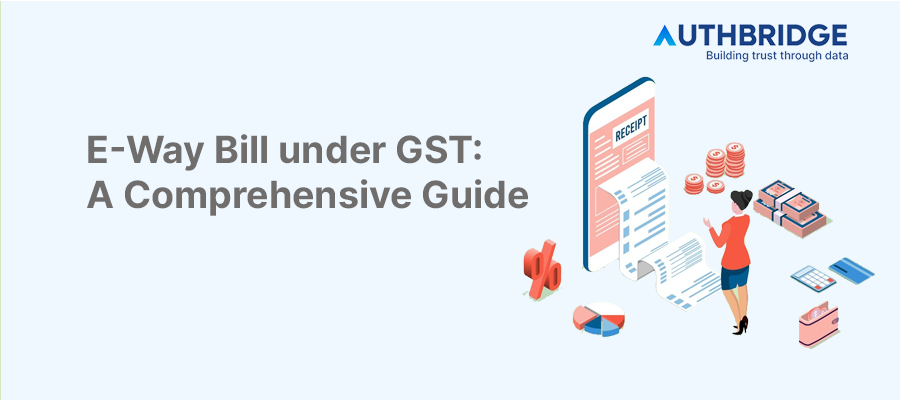Mastering E-Way Bills Under GST: A Step-by-Step Guide For Smooth Movement Of Goods

The Goods and Services Tax (GST) regime in India introduced the E-Way Bill, a revolutionary step towards digitizing logistics and ensuring tax compliance across the nation. This comprehensive guide delves into the nuances of the E-Way Bill, offering insights into its requirements, generation process, and the impact on businesses and logistics.
Introduction to E-Way Bill under GST
Definition and Purpose
An E-Way Bill is an electronic document required for the movement of goods worth more than Rs. 50,000. It serves as evidence of the consignment's compliance with GST regulations, aiming to streamline the tracking of goods movement, reduce tax evasion, and ensure seamless inter-state and intra-state transportation.
Legal Framework and Implementation Date
Rooted in the GST law, the E-Way Bill system was rolled out nationwide on April 1, 2018, for inter-state movement, with intra-state implementation following in phases. Governed by Section 68 of the CGST Act and Rule 138 of the CGST Rules, 2017, it mandates the generation of E-Way Bills through the GST portal.
E-Way Bill Requirements
When is E-Way Bill Required?
The E-Way Bill is mandatory for the inter-state and intra-state transport of goods exceeding Rs. 50,000 in value, applicable to both taxable and exempt goods. It encompasses various scenarios, including supplies, returns, and transfers, ensuring transparency and compliance across the supply chain.
Exemptions: When E-Way Bill is Not Required
Exemptions apply to the transport of goods by non-motorized conveyances, certain specified goods, and movements within specified areas. Notably, goods transported for customs clearance and certain exempted categories do not require an E-Way Bill, easing the process for specific transactions.
Generating E-Way Bills
Registration Process for E-Way Bill
To generate an E-Way Bill, businesses and transporters must register on the E-Way Bill portal using their GSTIN. The portal facilitates the entire process, from registration to bill generation, ensuring a user-friendly experience.
Step-by-Step Guide to Generate E-Way Bill
Generating an E-Way Bill involves logging into the portal, filling in the details of the consignment, and submitting the form to obtain an E-Way Bill Number (EBN). This process integrates seamlessly with the GST system, enabling real-time tracking and compliance verification.
Documents Required for E-Way Bill Generation
The generation process requires details from the tax invoice, bill of supply, or delivery challan, along with transporter ID and vehicle number. These documents ensure the accuracy and authenticity of the E-Way Bill.
Key Features and Functions of E-Way Bill
Validity of E-Way Bill
The validity of an E-Way Bill depends on the distance the goods are to be transported, with a standard validity period that begins from the time of bill generation. This period is extendable under specific circumstances, ensuring flexibility in logistics operations.
Updating and Cancelling E-Way Bill
E-Way Bills can be updated or cancelled through the portal within 24 hours of generation, provided the goods have not been verified in transit. This feature allows for corrections and adjustments, enhancing operational efficiency.
Special Cases and Considerations
E-Way Bill for Job Work and Handicraft Goods
Special provisions apply to the movement of goods for job work and handicraft items, requiring E-Way Bills regardless of the consignment value, facilitating smoother operations and compliance for these sectors.
Movement of Goods by Non-Motorised Conveyance
Goods transported by non-motorised conveyances are exempt from the E-Way Bill requirement, acknowledging traditional and rural modes of transport and reducing the compliance burden on small-scale traders and artisans.
Compliance and Penalties
Compliance Requirements
Compliance with E-Way Bill regulations is critical to avoid penalties. Businesses and transporters must ensure timely generation, accurate information, and adherence to validity periods to facilitate smooth goods movement.
Penalties for Non-Compliance
Non-compliance with E-Way Bill requirements can result in penalties, including fines and detention of goods. These measures underscore the importance of adherence to GST regulations and the E-Way Bill system.
Technological Aspects of E-Way Bill
E-Way Bill Portal and Mobile Application
The E-Way Bill portal and mobile application offer a robust platform for E-Way Bill generation, management, and compliance tracking. These technological tools are designed to simplify logistics and tax compliance, making the process accessible and efficient.
Bar Code and QR Code Features
E-Way Bills feature bar codes and QR codes, enabling quick verification and authentication of consignments. This technological integration facilitates easier inspections and reduces transit delays, enhancing the efficiency of goods movement.
Challenges and Solutions
Common Challenges in E-Way Bill Compliance
Businesses often face challenges in adapting to the E-Way Bill system, including technical glitches, understanding the nuances of bill generation, and managing compliance across state lines. These challenges can impact logistics and operational efficiency.
Solutions and Best Practices
Adopting best practices, such as regular training, leveraging technology for compliance management, and staying updated with regulatory changes, can mitigate these challenges. Additionally, the GST Council continually works to improve the system, addressing feedback from stakeholders.
Conclusion
The E-Way Bill system under GST represents a significant step towards digitizing India's tax compliance and logistics framework. While it introduces a layer of compliance, it also offers benefits in terms of efficiency, transparency, and reduced tax evasion. As businesses and transporters navigate this system, embracing technology and adhering to best practices will be key to leveraging its full potential, ensuring smooth operations and compliance in the dynamic landscape of GST.
Category

Abhinandan Banerjee
(Associate Manager - Marketing)
Abhinandan is a dynamic Product and Content Marketer, boasting over seven years of experience in crafting impactful marketing strategies across diverse environments. Known for his strategic insights, he propels digital growth and boosts brand visibility by transforming complex ideas into compelling content that inspires action.



